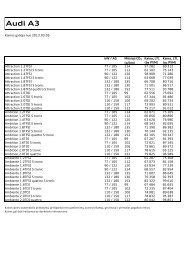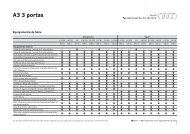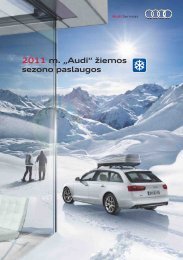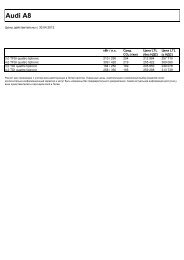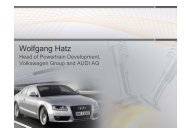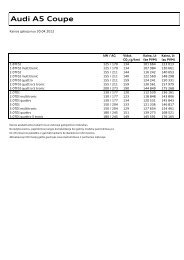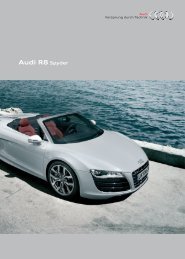Environmental Declaration 2010 for the Audi Plant in Ingolstadt
Environmental Declaration 2010 for the Audi Plant in Ingolstadt
Environmental Declaration 2010 for the Audi Plant in Ingolstadt
You also want an ePaper? Increase the reach of your titles
YUMPU automatically turns print PDFs into web optimized ePapers that Google loves.
Wastewater<br />
The most obvious fluctuations can be seen <strong>in</strong> <strong>the</strong><br />
evaporation volumes of <strong>the</strong> cool<strong>in</strong>g towers. In this case,<br />
<strong>the</strong> vary<strong>in</strong>g wea<strong>the</strong>r conditions <strong>in</strong> <strong>the</strong> <strong>in</strong>dividual years<br />
play a crucial role.<br />
Regular wastewater analyses<br />
This wastewater is analysed every day <strong>in</strong> order to<br />
check compliance with <strong>the</strong> prescribed limits. Thanks<br />
to a reliable and effective clean<strong>in</strong>g process, <strong>the</strong> limits<br />
<strong>for</strong> harmful substances are met by a large marg<strong>in</strong>, as<br />
is confirmed by <strong>the</strong> results of <strong>the</strong> <strong>in</strong>vestigations.<br />
Wastewater that might possibly conta<strong>in</strong> oil residues is<br />
passed by <strong>Audi</strong> through what are known as oil separators<br />
(volatile liquid separators). These separate e.g.<br />
grease, oil and petroleum from <strong>the</strong> watery phase, so<br />
that <strong>the</strong>y can be disposed of separately. In cooperation<br />
with an external eng<strong>in</strong>eer<strong>in</strong>g firm, <strong>Audi</strong> recorded<br />
all of its <strong>in</strong>stallations aga<strong>in</strong> <strong>in</strong> 2005 and made an<br />
<strong>in</strong>ventory of <strong>the</strong>m <strong>in</strong> an EDP system. The <strong>in</strong>stallations<br />
were also all checked <strong>for</strong> <strong>the</strong>ir structural condition at<br />
<strong>the</strong> same time.<br />
Older separator <strong>in</strong>stallations that can no longer<br />
guarantee <strong>the</strong> secure retention of volatile liquids will<br />
be gradually replaced by new systems. When <strong>in</strong>vest<strong>in</strong>g<br />
<strong>in</strong> new oil separators, <strong>Audi</strong> chooses modern, advanced<br />
systems that set new standards <strong>in</strong> terms of <strong>the</strong>ir<br />
efficiency and reliability. The second modernisation<br />
phase <strong>for</strong> <strong>the</strong> oil separators was concluded <strong>in</strong> <strong>the</strong> year<br />
under review. The measures have been cont<strong>in</strong>ued <strong>in</strong> a<br />
third modernisation phase s<strong>in</strong>ce <strong>the</strong> beg<strong>in</strong>n<strong>in</strong>g of<br />
<strong>2010</strong>. The wastewater quantity per vehicle has rema<strong>in</strong>ed,<br />
analogous to <strong>the</strong> total water consumption, at<br />
<strong>the</strong> 2007 level with 1.5 cubic metres.<br />
32<br />
Total wastewater volume<br />
<strong>in</strong> millions of m3<br />
1,25<br />
1,00<br />
0,75<br />
0,50<br />
0,25<br />
01<br />
02<br />
03<br />
04<br />
05<br />
Wastewater volume per vehicle<br />
<strong>in</strong> m3(with TT Coupé/Roadster)<br />
2,5<br />
2,0<br />
1,5<br />
1,0<br />
0,5<br />
0,0<br />
01<br />
02<br />
Harmful substance concentrations, 2009<br />
03<br />
(<strong>in</strong> <strong>the</strong> wastewater of Neutra I <strong>for</strong> <strong>the</strong> monitor<strong>in</strong>g parameters)<br />
<strong>in</strong> mg/l<br />
Mean value Limit value<br />
Nickel 0,049 0,5<br />
Z<strong>in</strong>c 0,140 2,0<br />
AOX 0,040 1,0<br />
Sulphide 0,135 1,0<br />
04<br />
05<br />
06<br />
06<br />
07<br />
07<br />
08<br />
08<br />
09<br />
09<br />
Calculation of <strong>the</strong> water volumes demonstrably not discharged <strong>in</strong>to <strong>the</strong> sewer system<br />
The total sum of <strong>the</strong> wastewater demonstrably<br />
not discharged is calculated from <strong>the</strong><br />
follow<strong>in</strong>g areas:<br />
Cool<strong>in</strong>g towers<br />
The evaporation <strong>in</strong> <strong>the</strong> cool<strong>in</strong>g towers is<br />
calculated from <strong>the</strong> difference between<br />
<strong>the</strong> make-up feed (metered) and blowdown<br />
(metered).<br />
Pa<strong>in</strong>t shops<br />
There are many processes <strong>in</strong>volv<strong>in</strong>g evaporation<br />
<strong>in</strong> <strong>the</strong> pa<strong>in</strong>t shops. In <strong>the</strong> case of dippa<strong>in</strong>t<strong>in</strong>g<br />
processes, water evaporates directly<br />
out of <strong>the</strong> baths and <strong>the</strong> dryer stages. Along<br />
with direct evaporation from <strong>the</strong> pa<strong>in</strong>ts and<br />
wash<strong>in</strong>g out, air humidification also plays an<br />
important role <strong>in</strong> <strong>the</strong> area of pa<strong>in</strong>t shop N56<br />
The water content <strong>in</strong> <strong>the</strong> separately disposed<br />
of pa<strong>in</strong>t sludge from <strong>the</strong> coagulation process<br />
and <strong>in</strong> <strong>the</strong> separately disposed of butyl<br />
glycol/water mixtures is to be considered of<br />
lesser importance.<br />
Most water flows can be recorded <strong>in</strong> terms of<br />
volume with flow meters. There are, however,<br />
also some split flows that cannot be detected,<br />
or water volumes <strong>in</strong> pa<strong>in</strong>t sludge and<br />
separately decontam<strong>in</strong>ated waste that can<br />
only be estimated. In <strong>the</strong>se cases, <strong>the</strong> choice<br />
of system limits <strong>for</strong> <strong>the</strong> <strong>in</strong>dividual areas is<br />
of crucial importance. This is because all of<br />
Use of ra<strong>in</strong>water<br />
Precipitation <strong>in</strong> m3<br />
<strong>the</strong> a<strong>for</strong>ementioned <strong>in</strong>dividual items can be<br />
worked out by means of a difference calculation<br />
(<strong>in</strong>flow <strong>in</strong>to <strong>the</strong> system m<strong>in</strong>us outflow<br />
from <strong>the</strong> system).<br />
In <strong>the</strong> case of <strong>in</strong>flows, <strong>the</strong> <strong>in</strong>puts of Kösch<strong>in</strong>g<br />
water as well as process water and dr<strong>in</strong>k<strong>in</strong>g<br />
water <strong>in</strong>to <strong>the</strong> processes <strong>in</strong>volv<strong>in</strong>g <strong>in</strong>tensive<br />
evaporation are all taken <strong>in</strong>to account. The<br />
outflows from <strong>the</strong>se processes are recorded<br />
accord<strong>in</strong>gly. The difference between <strong>the</strong><br />
metered <strong>in</strong>flows and outflows corresponds<br />
to <strong>the</strong> demonstrably non-discharged wastewater<br />
volumes.<br />
Separately disposed of oil/water mixtures<br />
Some oil/water mixtures used to be disposed<br />
of externally, so <strong>the</strong> proportion of water<br />
(90 percent) did not get <strong>in</strong>to <strong>the</strong> sewer<br />
system. With <strong>the</strong> commission<strong>in</strong>g of an emulsion<br />
vaporisation plant on <strong>the</strong> plant premises,<br />
used emulsions and wash<strong>in</strong>g water have been<br />
separated at <strong>the</strong> plant s<strong>in</strong>ce 2006.<br />
The proportion of non-discharged water is<br />
reduced as a result.<br />
Passed on to <strong>the</strong> product<br />
The cars produced must be filled with<br />
coolant water and <strong>the</strong> w<strong>in</strong>dscreen wash<strong>in</strong>g<br />
system must be topped up.<br />
<strong>Audi</strong> estimates around 5.5 litres of coolant<br />
water per vehicle, and around 2.25 litres <strong>for</strong><br />
<strong>the</strong> w<strong>in</strong>dscreen wash<strong>in</strong>g system.<br />
2001 2002 2003 2004 2005 2006 2007 2008 2009<br />
Precipitation 183.554 174.600 181.069 213.891 184.577 141.953 238.799 211.495 236.226<br />
33






